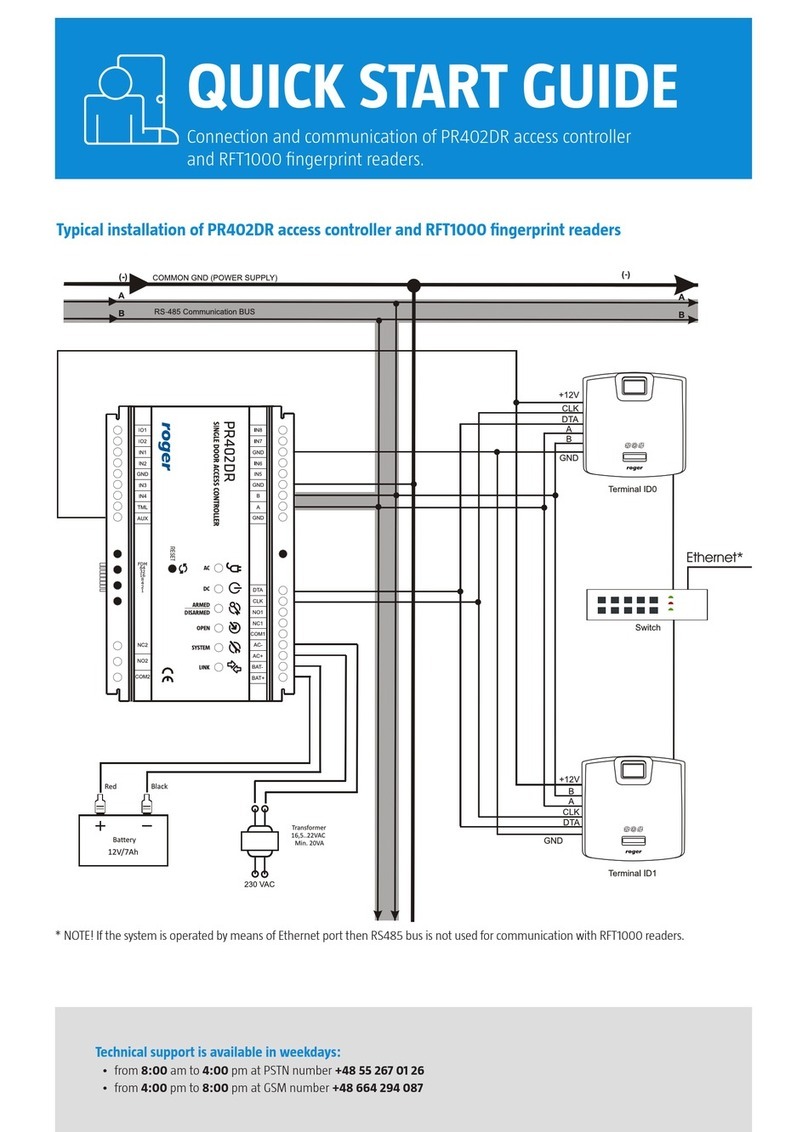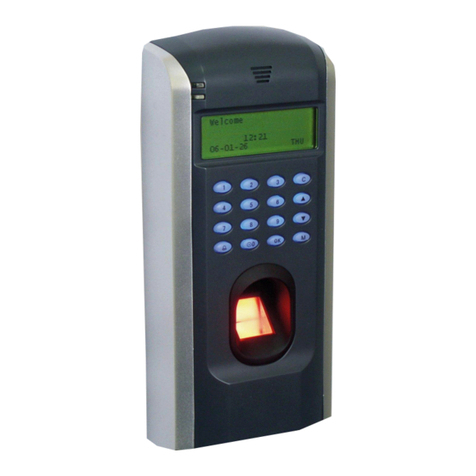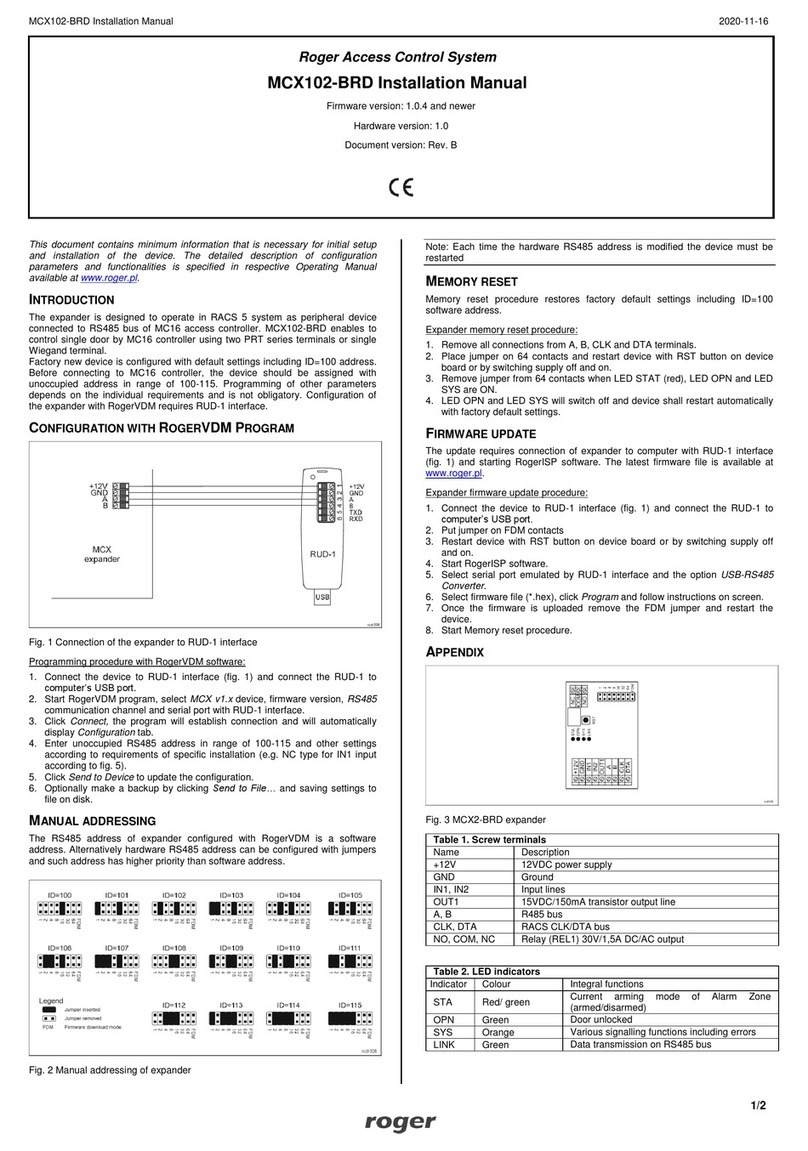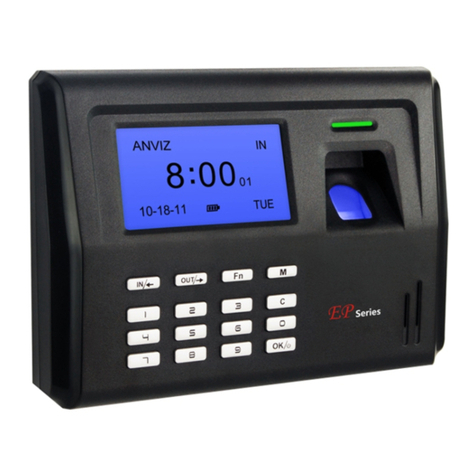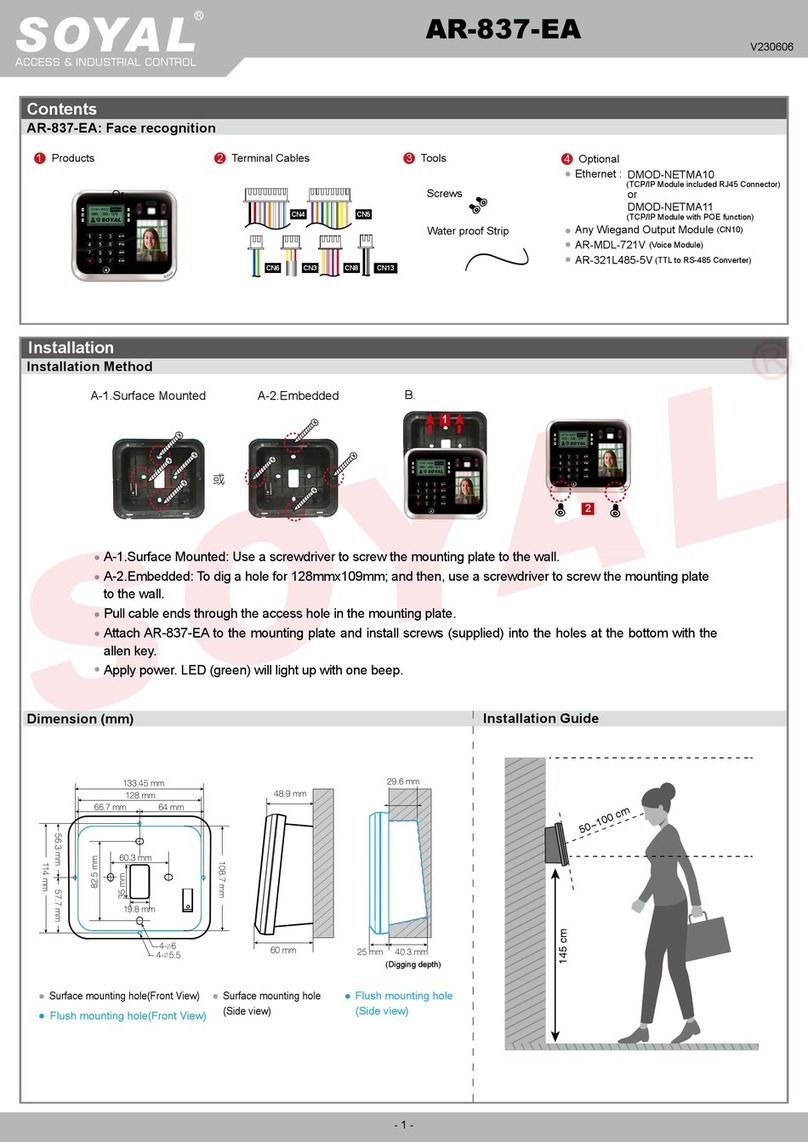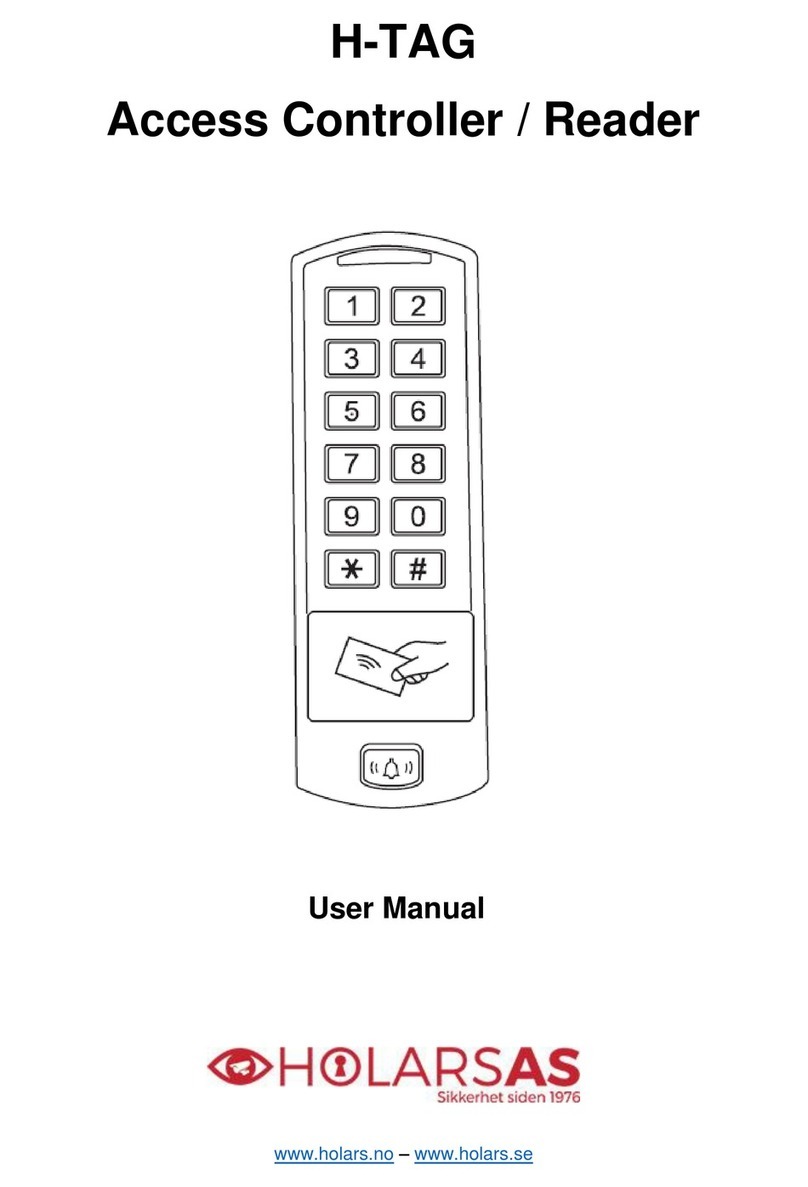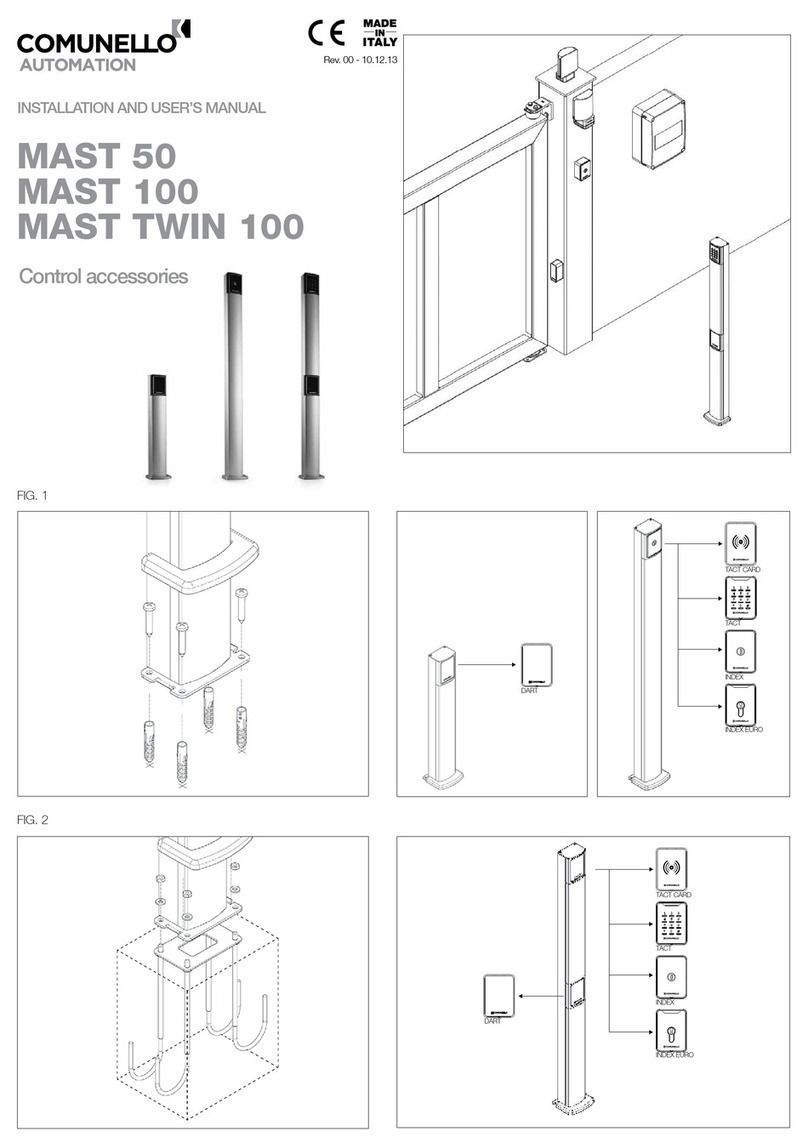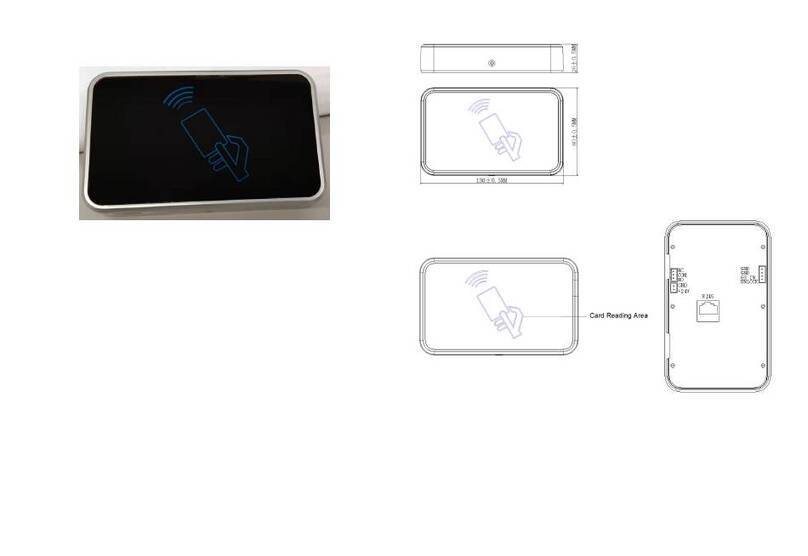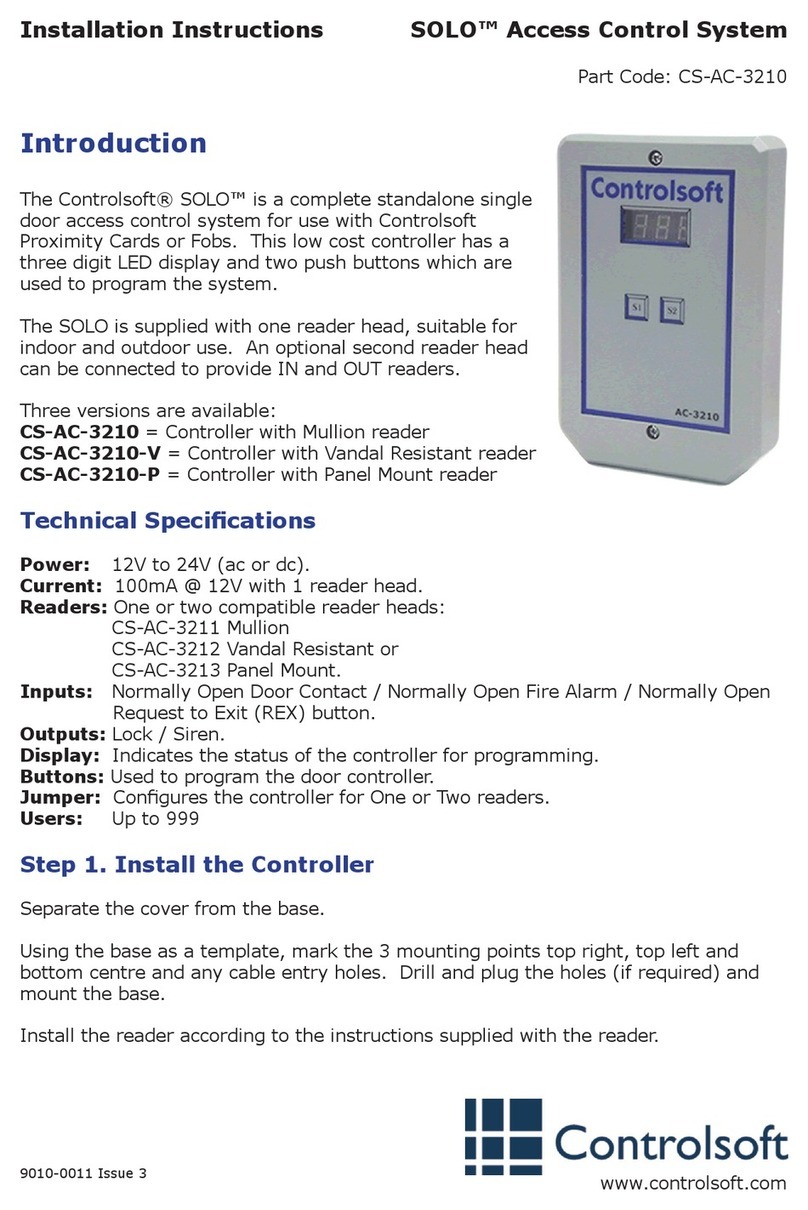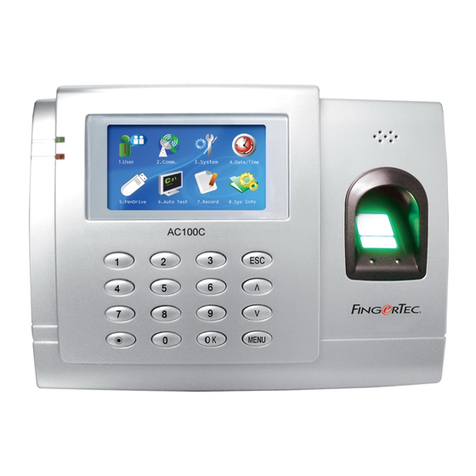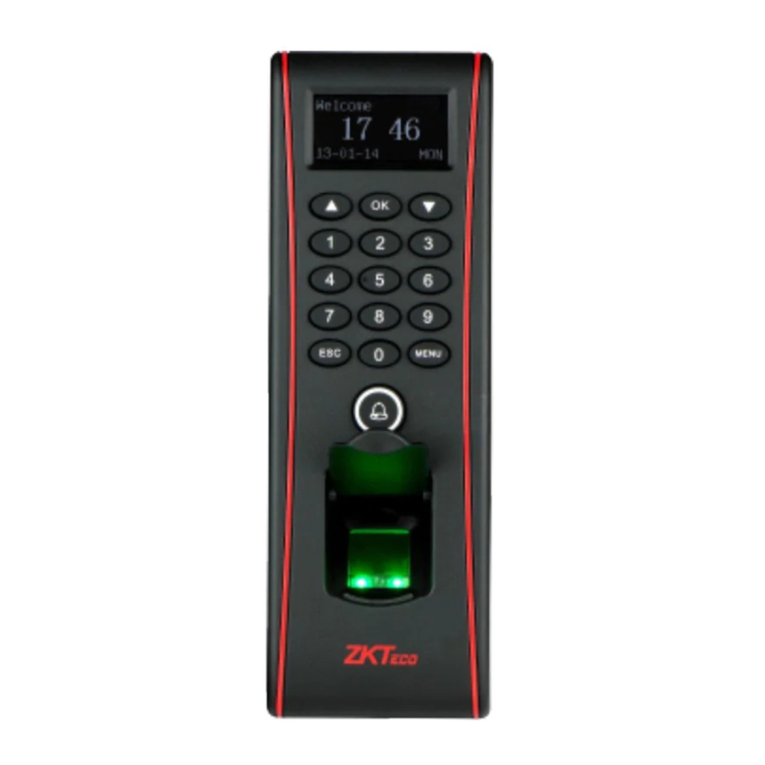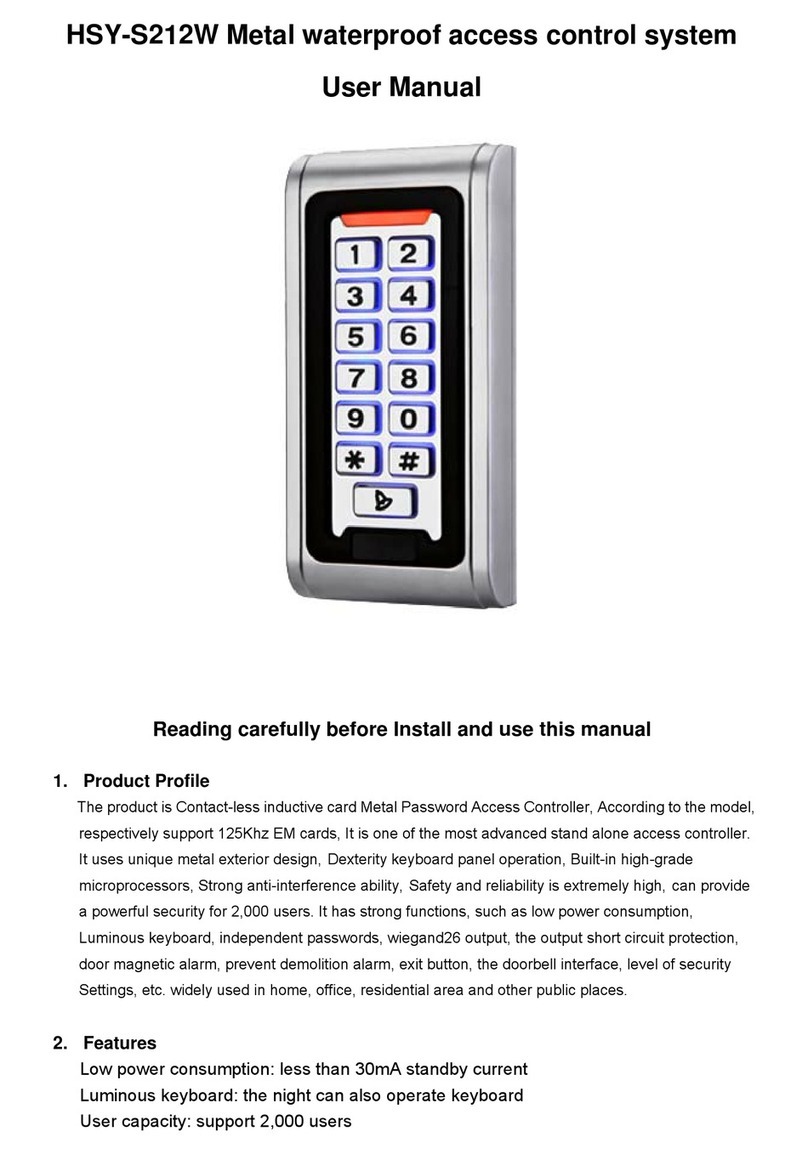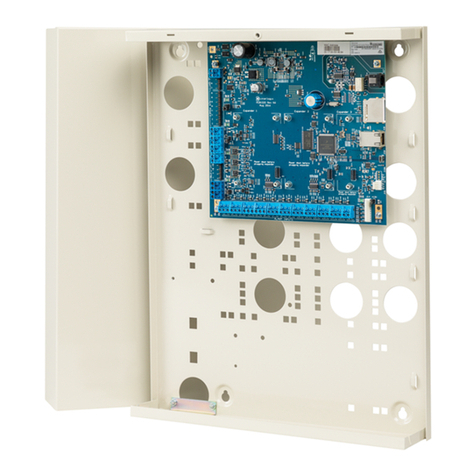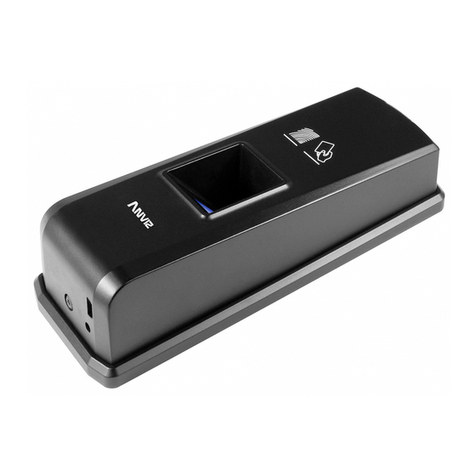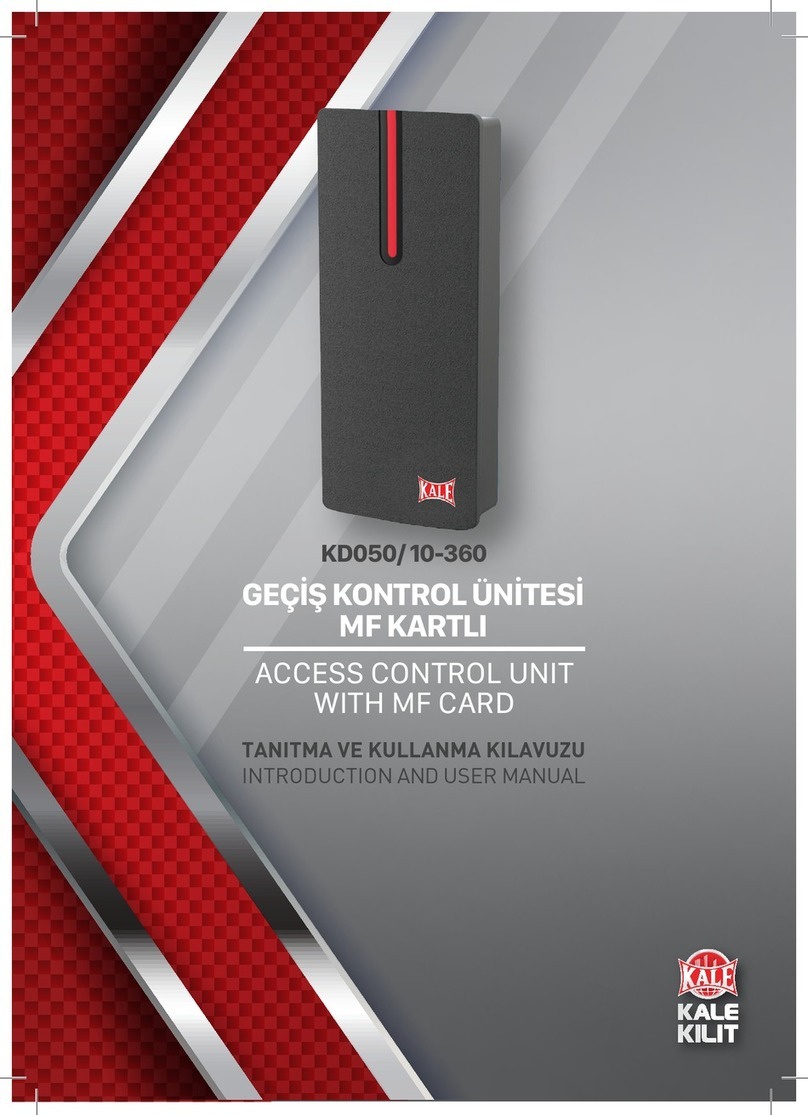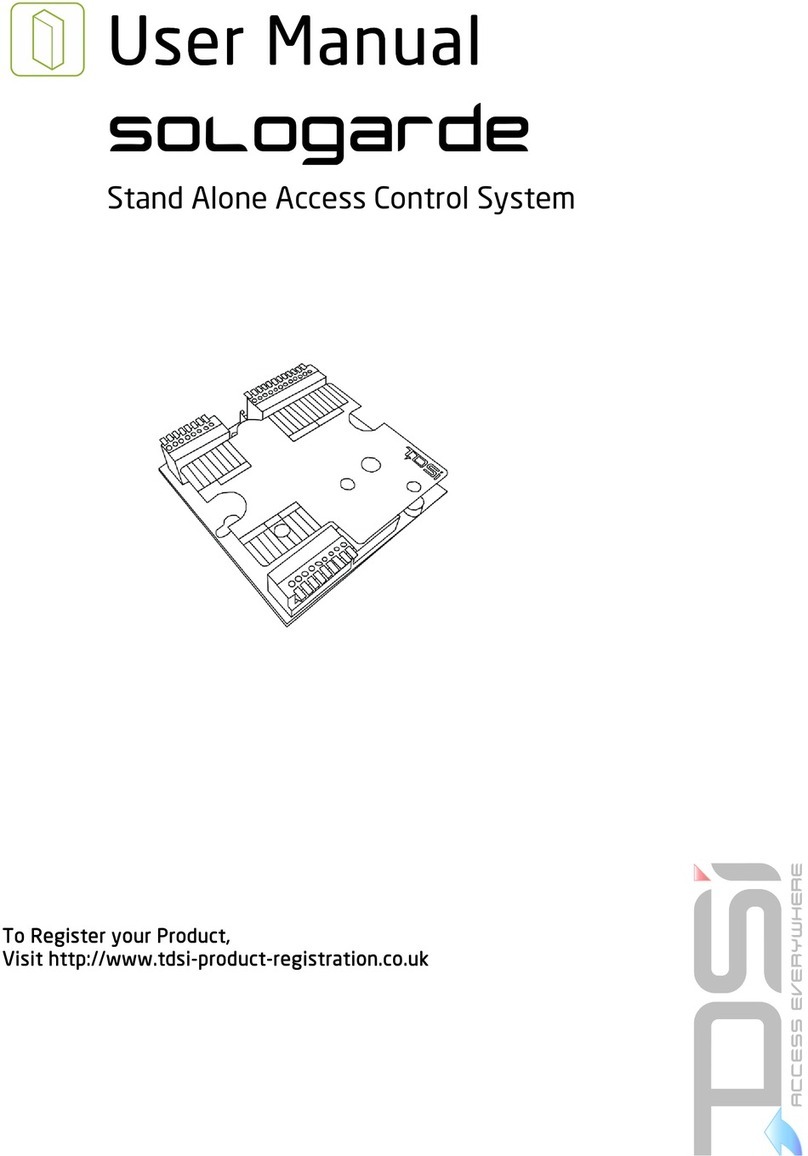Roger OSR88M-IO User manual

Roger Access Control System
OSR88M-IO Operating Manual
Product version: 1.0
Firmware version: 1.0.8.205 or newer
Document version: Rev.B

OSR88M-IO Operating Manual.doc 20/10/2023
2/18
1. DESIGN AND APPLICATION
The OSR88M-IO is an identification terminal dedicated to work with an access controller that supports the
OSDP v2.2 protocol. The terminal is equipped with colour graphic display, sensor type keypad, 4 function
keys and MIFARE Ultralight/Classic/DESFire/Plus/ reader. Users can identify at the terminal with PINs,
MIFARE cards or mobile devices equipped with NFC (Near Field Communication) and BLE (Bluetooth Low
Energy) interfaces. MCT88M-IO can be connected to RS485 bus of MC16 access controller using the
additional MCI-3-LCD interface. When connected to MC16 controller it can be operated as access control
terminal, Time&Attendance terminal and additionally it can be used to control the system especially in
regard of building automation offered by RACS 5.
Characteristics
•Access terminal supporting OSDP v2.2
•Colour graphic display
•MIFARE Ultralight/Classic/DESFire/Plus cards reader
•NFC and BLE mobile identification
•Touch type keypad
•4 function keys
•3 inputs
•2 transistor outputs
•1 relay output
•RS485 interface
•Dimensions: 155,5 x 85,0 21,5
•CE
Power supply
The terminal requires power supply voltage in range of 11-15VDC. It can be supplied from MCX2D/MCX4D
expander of MC16-PAC-KIT, from MC16 access controller (e.g. TML output) or from dedicated power
supply unit. The supply wire diameter must be selected in such way that the voltage drop between supply
output and the device would be lower than 1V. The proper wire diameter is especially critical when device is
located in long distance from the supply source. In such a case the use of dedicated power supply unit
located close to the device should be considered. When separate power supply unit is used then its minus
should be connected to controller’s GND by means of signal wire with any diameter. It is recommended to
use UTP cable for connection of device to controller. The table below shows maximal UTP cable lengths in
relation to the number of wires used for power supply.
Table 1. Power supply cabling
Number of UTP wire pairs for power supply
Maximal length of power supply cable
1
150m
2
300m
3
450m
4
600m

OSR88M-IO Operating Manual.doc 20/10/2023
3/18
Fig. 1 OSR supply from MC16 access controller
Fig. 2 OSR supply from dedicated power supply unit
OSDP bus
The communication method with access controller is provided via the OSDP protocol on the RS485 bus.
The device can be connected directly to access controllers supporting this bus. However, for the MC16
controller, it is additionally necessary to use the MCI-3-LCD interface. The bus topology can be freely
arranged as star, tree or any combination of them except for loop. The matching resistors (terminators)
connected at the ends of transmitting lines are not required. In most cases communication works with any
cable type (standard telephone cable, shielded or unshielded twisted pair etc.) but the recommended cable
is unshielded twisted pair (U/UTP cat.5). Shielded cables should be limited to installations subject to strong
electromagnetic interferences. The RS485 communication standard used in the RACS 5 system guarantees
proper communication in a distance of up to 1200 meters as well as high resistance to interferences.
Note: Do not use more than single pair in UTP cable for RS485 communication bus.

OSR88M-IO Operating Manual.doc 20/10/2023
4/18
Display
The terminal is equipped with colour display (4 lines, 16 characters each). The display can be configured in
regard of background and font colours within low level configuration (RogerVDM) and in regard of displayed
information within high level configuration by means of Display command in VISO software navigation tree
which is explained in AN011 application note.
Moreover, default functions key icons, splash screen and screensaver can be replaced using device
memory card. Four new icons must be copied to ICONS folder on memory card (fig. 6) and they must be
named as icon_001.bmp, icon_002.bmp, icon_003.bmp and icon_004.bmp. Splash screen file in the same
folder must be named as icon_000.bmp. Screensaver graphics must be named as scrnsvr.bmp and it must
be copied to the main folder of memory card. Icons, splash screen and screen saver must in bmp format
(without alpha channel) and with 24bit colour depth (can be saved with MS Paint). Icon size must be
60x60pixels while splash screen size and screen saver size must be 320x240pixels.
Keypad
The terminal is equipped with numeric touch keypad and backlight. The keypad can be used for user
identification with PIN and for various keypad commands. By default, the key [#] is used for PIN confirming.
Function keys
The terminal is equipped with four touch function keys (fig. 3). Various functions can be assigned to these
keys within high level configuration (VISO) e.g. door bell, Set T&A Mode, Register Guard Tour Event, Set
Automation Node On, etc. Within low level configuration (RogerVDM) function buttons can be enabled.
Fig. 3 LED indicators and function keys
LED indicators
The terminal is equipped with three LED indicators (fig. 3) which are used to signal integral functions and
they can be additionally programmed with other available functions within high level configuration (VISO).
Table 2. LED indicators
Indicator
Colour
Integral functions
LED STATUS
Red/green
Default colour of the indicator is red. If the terminal is assigned to
Alarm Zone then the LED indicates zone arming (red) or disarming
(green).
LED OPEN
Green
LED indicates access granting.

OSR88M-IO Operating Manual.doc 20/10/2023
5/18
LED SYSTEM
Orange
LED indicates card reading and can signal other system functions
including device malfunction.
Note: Synchronic pulsing of LED indicators signifies lost communication with MC16 controller.
Buzzer
The terminal is equipped with buzzer which is used to signal integral functions and it can be additionally
programmed with other available functions within high level configuration (VISO).
Note: LED indicators, speaker and output lines in high-level configuration (VISO) can only be controlled as
on/off. Unlike MCT readers, flashing or cyclic activation is not supported.
Inputs
The terminal offers 3 general purpose inputs of NO, NC and 1 input internally connected to tamper contact.
Input types and electric parameters such as response time and parametric resistors are defined within low
level configuration (RogerVDM). Input functions are assigned within high level configuration (VISO). Multiple
functions can be assigned to the same input at the same time.
Table 3. Input types
NO input
NC input
NO input can be in normal or in triggered state. In
normal state CAcontacts are opened. Input
triggering is caused by CAcontacts closing.
NC input can be in normal or in triggered state. In
normal state CAcontacts are closed. Input triggering
is caused by CAcontacts opening.
Response time
Response time parameter defines minimal impulse time on the input which triggers the input. Each input can
be configured individually in range of 50 to 5000 ms within low level configuration (RogerVDM).
Tamper detector
Built-in tamper (sabotage) detector enables detection of unauthorized opening of device’s enclosure as well
as detachment of the enclosure from wall. The detector is internally connected to the terminal’s input. It
does not require low level configuration (RogerVDM) or any additional installation arrangements but it is
essential to mount front panel in such way as the tamper detector (fig. 6) would firmly press the back panel.
The detector requires high level configuration which consists in assignment of the function [133] Tamper
Toggle on the level of a Main Board of a controller in VISO software navigation tree.
Outputs
The terminal offers 2 transistor open collector type outputs (15V/150mA rated) and 1 relay output with
NO/NC contacts (30V/1.5A DC/AC rated). Electric parameters such as polarity are configured within low

OSR88M-IO Operating Manual.doc 20/10/2023
6/18
level configuration (RogerVDM). Function are assigned to outputs within high level configuration (VISO).
Multiple functions with different priorities can be assigned to the same output at the same time.
Identification
Following user identification methods are offered by the terminal:
•MIFARE Ultralight/Classic/Plus/DESFire proximity cards
•PINs
•Mobile devices (NFC and BLE)
MIFARE cards
By default the terminal reads serial numbers (CSN) of MIFARE cards but it is possible to program cards with
own numbers (PCN) in selected and encrypted sectors of card memory. The use of PCN prevents card
cloning and consequently it significantly increases security in the system. More information on MIFARE card
programming is given in AN024 application note which is available at www.roger.pl.
The technical characteristics of the device are guaranteed for RFID cards supplied by Roger. Cards from
other sources may be used, but they are not covered by the manufactures warranty. Before deciding to use
specific Roger products with third-party contactless cards, it is recommended to conduct tests that will
confirm satisfactory operation with the specific Roger device and software in which it operates.
PINs
The terminal accepts variable length PINs (by default 4-8 digits concluded with [#] key).
Mobile devices (NFC and BLE)
The terminal OSR88M-IO enables user identification with mobile device (Android, iOS) using NFC or
Bluetooth (BLE) communication. Prior to use of BLE/NFC identification on the terminal, within its low level
configuration (see section 4) configure own NFC/BLE authentication factor encryption key and NFC/BLE
communication encryption key while in case of Bluetooth additionally verify if the parameter BLE activated is
enabled. Install Roger Mobile Key (RMK) app on mobile device and configure the same parameters as in
the terminal. Create key (authentication factor) in RMK defining its type and number, then create the same
authentication factor in VISO software (fig. 4) and assign it to the user with adequate Authorisation(s) at the
terminal. When user wants to identify at the terminal using mobile device then key (authentication factor)
can be selected from the screen or with gesture.
Fig. 4 Authentication factor type in VISO software
2. INSTALLATION
Table 4. Screw terminals

OSR88M-IO Operating Manual.doc 20/10/2023
7/18
Name
Description
OUT2
OUT2 output line
OUT1
OUT1 output line
IN3
IN3 input line
IN2
IN2 input line
IN1
IN1 input line
NO
REL1 relay normally opened contact
NC
REL1 relay normally closed contact
COM
REL1 relay common contact
B
OSDP bus, line B
A
OSDP bus, line A
GND
Ground
+12V
12VDC power supply
1,2,3,4,5,6,7,8
Ethernet port

OSR88M-IO Operating Manual.doc 20/10/2023
8/18
Fig. 5 OSR88M-IO installation

OSR88M-IO Operating Manual.doc 20/10/2023
9/18
Fig. 6 Internal side of the front panel
Installation guidelines
•The terminal should be mounted on a vertical structure (wall) away from sources of heat and
moisture.
•Front panel should be attached in such way as the tamper detector (fig. 6) would firmly press the
back panel.
•All electrical connections should be done with disconnected power supply.
•If the terminal and controller are not supplied from the same PSU then GND terminals of both
devices must be connected with any wire.
•Device can be cleaned by means of wet cloth and mild detergent without abrasive components. In
particular do not clean with alcohols, solvents, petrol, disinfectants, acids, rust removers, etc.
Damages resulting from improper maintenance and usage are not covered by manufacturer
warranty.
3. OPERATION SCENARIOS
Connection vis MCI-3-LCD interface
The terminal when connected to MC16 access controller via the MCI-3-LCD interface, can be at the same
time used for access control, Time&Attendance and to control external devices with function keys. The
example of connection diagram for such scenario is shown in fig. 7 where the terminal is connected via the
MCI-3-LCD interface to the MC16 controller. The terminal with MCI-3-LCD interface can also operate with
MC16 controller using MCX2D/MCX4D expanders as in case of M16-PAC-x-KIT series.
In order to support OSDP terminals, it is necessary to run the automatic terminal detection procedure via the
MCI interface. The OSDP terminal detection procedure is described in a separate manual for the MCI-3-
LCD interface.

OSR88M-IO Operating Manual.doc 20/10/2023
10/18
Fig. 7 Typical connection diagram for the terminal and MC16 access controller via the MCI-3-LCD interface.
Direct connection to the OSDP controller
It is possible to make a direct connection of the OSR reader directly to the OSDP controller. An exemplary
connection diagram is shown below.
Fig. 8 Connecting the OSR reader directly to the OSDP controller
4. CONFIGURATION
The purpose of low level configuration is to prepare device for operation in RACS 5 system. In case of
RACS 5 v1 or RACS5 v2 system the address of device must be configured by means of RogerVDM
software or by manual addressing before connection to MC16 controller.

OSR88M-IO Operating Manual.doc 20/10/2023
11/18
Low level configuration (RogerVDM)
Fig. 9 Connection to RUD-1 interface.
Programming procedure with RogerVDM software:
1. Connect the device to RUD-1 interface (fig. 9) and connect the RUD-1 to computer’s USB port.
2. Remove jumper from MEM contacts (fig. 6) if it is placed there.
3. Restart the device (switch power supply off and on) and orange LED SYSTEM will pulsate. Then within
5 seconds place jumper on MEM contacts and the terminal will display CONFIG MODE text.
4. Start RogerVDM program, select OSR device, v1.0 firmware version, RS485 communication channel
and serial port with RUD-1 interface.
5. Click Connect, the program will establish connection and will automatically display Configuration tab.
6. Select RS485 communication interface and specify unoccupied RS485 address in range of 0-126.
Configure other low level configuration parameters as needed.
7. Click Send to Device to update the configuration of device.
8. Optionally make a backup by clicking Send to File… and saving settings to file on disk.
9. Remove jumper from MEM contacts and disconnect device from RUD-1 interface.
Note: If the USB port does not offer enough power output then supply the terminal from external PSU with
min. 12VDC/200mA power output.
Note: Do not read any cards nor press keypad when device is configured with RogerVDM.
Table 5. List of low level parameters
Communication settings
OSDP address
Parameter defines device address on OSDP bus. Range: 0-126.
Default value: 0.
Factor conversion
Parameter defines method of converting the read factor. Value range:
[0]: RS485 (EPSO3), [1]: Media only. Default value: [0]: RS485
(EPSO3)
LED control
Parameter defines method of controlling the terminal's LED indicators.
Range of values: [0]: 4 monochrome indicators [1]: RGB tricolor
indicator. Default value: [0]: 4 monochrome indicators
Communication encryption
Parameter defines the encryption conditions for communication
between the controller (CP) and the reader (PD). Encryption can be
unconditional at all times or managed by a controller. Range of values:
[0]: Controller initiated, [1]: Constant. Default value: [0]: Controller
initiated.

OSR88M-IO Operating Manual.doc 20/10/2023
12/18
OSDP password
Password for encrypting communication on the OSDP bus. Value
range: 4-16 ASCII characters.
Mobile authentication
NFC/BLE authentication factor
encryption key
Parameter defines key for encryption of NFC/BLE communication.
Range: 4-16 ASCII characters.
NFC/BLE communication
encryption key
Parameter defines key for encryption of NFC/BLE communication.
Range: 4-16 ASCII characters.
BLE authentication factor class
Parameter defines acceptable type of keys (authentication factors)
created in Roger Mobile Key app for Bluetooth (BLE) communication.
UCE means lower security and quicker identification while REK means
higher security and slower identification. It is necessary to apply
classes in RMK which are acceptable for terminal. Range: [1]: REK,
[2]: UCE, [3]: UCE + REK. Default value: [3]: UCE + REK.
NFC authentication factor class
Parameter defines acceptable type of keys (authentication factors)
created in Roger Mobile Key app for NFC communication. UCE means
lower security and quicker identification while REK means higher
security and slower identification. It is necessary to apply classes in
RMK which are acceptable for terminal. Range: [1]: REK, [2]: UCE, [3]:
UCE + REK. Default value: [2]: UCE.
Optical signalisation
RS485 communication timeout [s]
Parameter defines the delay after which the device will start signaling
lack of communication with the controller on the LED indicators. Value
0 disables signaling. Value range: 0-64 seconds. Default value 20.
LED SYSTEM pulsing when card
near reader
Parameter enables LED SYSTEM (orange) pulsing when card is close
to the device. Range: [0]: No, [1]: Yes. Default value: [0]: No.
Backlight level [%]
Parameter defines backlight level. When set to 0 then backlight is
disabled. Range: 0-100. Default value: 100.
Backlight switching off when no
activity
Parameter enables temporary backlight dimming whenever card is
read or key is pressed. Range: [0]: No, [1]: Yes. Default value: [0]:
Yes.
LED SYSTEM flash after card
read
Parameter enables short flash of LED SYSTEM (orange) when card is
read. Range: [0]: No, [1]: Yes. Default value: [1]: Yes.
Acoustic signalisation
Buzzer loudness level [%]
Parameter defines buzzer loudness level. When set to 0 then buzzer is
disabled Range: 0-100. Default value: 100.
Short sound after card read
Parameter enables short sound (beep) generating by buzzer when
card is read. Range: [0]: No, [1]: Yes. Default value: [1]: Yes.
Short sound after key press
Parameter enables short sound (beep) generating by buzzer when key
is pressed. Range: [0]: No, [1]: Yes. Default value: [1]: Yes.
Keypad settings
Keypad activated
Parameter enables deactivation of keypad. Range: [0]: No, [1]: Yes.
Default value: [1]: Yes.
Advanced settings
Card/PIN buffer timeout [s]
Parameter defines the time of keeping the card number or PIN code in
the reader's buffer. After exceeding this time, the identifier will be
deleted even though it has not been sent to the controller. Range: 1-
64. Default value: 10.
BLE activated
Parameter enables deactivation of Bluetooth transmission. Range: [0]:

OSR88M-IO Operating Manual.doc 20/10/2023
13/18
No, [1]: Yes. Default value: [1]: Yes.
BLE session timeout [s]
Parameter defines maximal time for establishing connection between
mobile device and terminal in Bluetooth technology. When timeout
elapses the session is interrupted by terminal so mobile device could
attempt to establish connection again. When set to 0 then timeout is
disabled. Range: 0-10. Default value: 5.
BLE broadcasting power [dBm]
Parameter defines power of broadcasting radio signal for Bluetooth
communication. Range: [1]: -18, [2]: -12, [3]: -6, [4]: -3, [5]: -2, [6]: -1,
[7]: 0. Default value: [1]: -18.
BLE transmission power [dBm]
Parameter defines power of transmission radio signal for Bluetooth
communication. Range: [0]: Auto; [1]: -18, [2]: -12, [3]: -6, [4]: -3, [5]: -
2, [6]: -1, [7]: 0. Default value: [0]: Auto.
Input types
IN1
Parameter defines input type. Range: [1]: NO, [2]: NC. Default value:
[1]: NO.
IN2
Parameter defines input type. Range: [1]: NO, [2]: NC. Default value:
[1]: NO.
IN3
Parameter defines input type. Range: [1]: NO, [2]: NC. Default value:
[1]: NO.
Input response times
IN1 [ms]
Parameter defines minimal duration of pulse which is required to
trigger the input. Range: 50-5000. Default value: 50.
IN2 [ms]
Parameter defines minimal duration of pulse which is required to
trigger the input. Range: 50-5000. Default value: 50.
IN2 [ms]
Parameter defines minimal duration of pulse which is required to
trigger the input. Range: 50-5000. Default value: 50.
Output polarity
OUT1
Parameter defines polarity of output. Normal polarity means that the
output by default is switched off while Reversed polarity means that
the output by default is switched on. Range: [0]: Normal polarity, [1]:
Reversed polarity. Default value: [0]: Normal polarity.
OUT2
Parameter defines polarity of output. Normal polarity means that the
output by default is switched off while Reversed polarity means that
the output by default is switched on. Range: [0]: Normal polarity, [1]:
Reversed polarity. Default value: [0]: Normal polarity.
REL1
Parameter defines polarity of output. Normal polarity means that the
output by default is switched off while Reversed polarity means that
the output by default is switched on. Range: [0]: Normal polarity, [1]:
Reversed polarity. Default value: [0]: Normal polarity.
Display
Default background colour
Parameter defines default colour of font background.
Default font colour
Parameter defines default colour of fonts.
Default font background colour
Parameter defines default colour of font background.
File name with additional
characters
File name with additional characters.
Screensaver
Parameter enables screensaver displaying. Range: [0]: No, [1]: Yes.
Default value: [1]: Yes.
Screensaver display delay [s]
Parameter defines inactivity time before screensaver displaying.

OSR88M-IO Operating Manual.doc 20/10/2023
14/18
Range: 0-3600. Default value: 60.
Serial card number (CSN) settings
Serial number length (CSNL) [B]
Parameter defines the number of bytes from serial card number (CSN)
which will be used to generate returned card number (RCN). RCN is
the actual card number read by reader and it is created as sum of
serial card number (CSN) and programmable card number (PCN).
Default value: 8.
Programmable card number (PCN) settings for Mifare Ultralight
Sector type
Parameter defines sector type with programmable number (PCN). If
the option [0]:None is selected then card returned number (RCN) will
include only CSN and PCN will be discarded. Range: [0]: None, [1]:
SSN. Default value: [0]: None.
SSN first page number
Parameter defines location of SSN in card memory. Range: 4-12.
Default value: 4.
Programmable card number (PCN) settings for Mifare Classic
Sector type
Parameter defines sector type with programmable number (PCN). If
the option [0]:None is selected then card returned number (RCN) will
include only CSN and PCN will be discarded. Range: [0]: None, [1]:
SSN, [2]: MAD. Default value: [0]: None.
Format
Parameter defines format of PCN. Range: [0]: BIN, [1]: ASCII HEX.
Default value: [0]: BIN.
First byte position (FBP)
Parameter defines the position of the first byte for PCN in data block
on card. Range: 0-15. Default value: 0.
Last byte position (LBP)
Parameter defines the position of the last byte for PCN in data block
on card. Range: 0-15. Default value: 7.
Sector ID
Parameter defines sector number where PCN is stored. Range: 0-39.
Default value: 1.
Application ID (AID)
Parameter defines application ID number (AID) which indicates sector
where PCN number is stored. Range: 0-9999. Default value: 5156.
Block ID
Parameter defines block number where PCN is stored. Range: 0-2 to
for sectors 0-31 and 0-14 for sectors 32-39. Default value: 0.
Key type
Parameter defines key type used to access sector with PCN. Range:
[0]: A, [1]: B, [2]: Roger. Default value: [0]: A.
Key
Parameter defines 6 bytes (12 HEX digits) key for accessing sector
where PCN is stored.
Programmable card number (PCN) settings for Mifare Plus
Sector type
Parameter defines sector type with programmable number (PCN). If
the option [0]:None is selected then card returned number (RCN) will
include only CSN and PCN will be discarded. Range: [0]: None, [1]:
SSN, [2]: MAD. Default value: [0]: None.
Format
Parameter defines format of PCN. Range: [0]: BIN, [1]: ASCII HEX.
Default value: [0]: BIN.
First byte position (FBP)
Parameter defines the position of the first byte for PCN in data block
on card. Range: 0-15. Default value: 0.
Last byte position (LBP)
Parameter defines the position of the last byte for PCN in data block
on card. Range: 0-15. Default value: 7.
Sector ID
Parameter defines sector number where PCN is stored. Range: 0-39.
Default value: 1.

OSR88M-IO Operating Manual.doc 20/10/2023
15/18
Application ID (AID)
Parameter defines application ID number (AID) which indicates sector
where PCN number is stored. Range: 0-9999. Default value: 5156.
Block ID
Parameter defines block number where PCN is stored. Range: 0-2 to
for sectors 0-31 and 0-14 for sectors 32-39. Default value: 0.
Key type
Parameter defines key type used to access sector with PCN. Range:
[0]: A, [1]: B. Default value: [0]: A.
Sector type
Parameter defines sector type with programmable number (PCN). If
the option [0]:None is selected then card returned number (RCN) will
include only CSN and PCN will be discarded. Range: [0]: None, [1]:
SSN, [2]: MAD. Default value: [0]: None.
Programmable card number (PCN) settings for Mifare Desfire
Sector type
Parameter defines sector type with programmable number (PCN). If
the option [0]:None is selected then card returned number (RCN) will
include only CSN and PCN will be discarded. Range: [0]: None, [1]:
Desfire file. Default value: [0]: None.
Format
Parameter defines format of PCN. Range: [0]: BIN, [1]: ASCII HEX.
Default value: [0]: BIN.
First byte position (FBP)
Parameter defines the position of the first byte for PCN in data block
on card. Range: 0-15. Default value: 0.
Last byte position (LBP)
Parameter defines the position of the last byte for PCN in data block
on card. Range: 0-15. Default value: 7.
Application ID (AID)
Parameter defines application ID number (AID) which indicates sector
where PCN number is stored. Range: 0-9999. Default value: F51560.
File ID (FID)
Parameter defines file identifier in AID. Range: 0-32 for Desfire EV1
and 0-16 for Desfire EV0. Default value: 0.
Communication protection level
Parameter defines encryption method for communication between
card and reader. Range: [0]: Plain, [1]: Data authentication by MAC,
[2]: Full encryption. Default value: [0]: Plain.
Key number
Parameter defines application key number used for file read. Range:
0-13. Default value: 0.
Key type
Parameter defines encryption key type for Desfire file. Range: [0]:
TDES Native, [1]: TDES Standard, [2]: 3-KTDES, [3]: AES128. Default
value: [0]: TDES Native.
Key
Parameter defines access key for Desfire file with PCN. 3-KTDES key
is 24 bytes (48 HEX digits), TDES and AES keys are 16 bytes (32
HEX digits).
Manual addressing
Manual addressing procedure enables configuration of new OSDP address with all other settings
unchanged.
Manual addressing procedure:
1. Remove all connections from A and B lines.
2. Remove jumper from MEM contacts (fig. 6) if it is placed there.
3. Restart the device (switch power supply off and on) and orange LED SYSTEM will pulsate. Then within
5 seconds place jumper on MEM contacts and the terminal will display CONFIG MODE text.
4. Enter 3 digits of OSDP address in range of 000-126 with keypad.
5. Wait till device starts to emit continuous sound.
6. Leave jumper on MEM.
7. Restart the device.

OSR88M-IO Operating Manual.doc 20/10/2023
16/18
Memory reset
Memory reset procedure resets all settings to factory default ones including ID=0 address.
Memory reset procedure:
1. Remove all connections from A and B lines.
2. Remove jumper from MEM contacts (fig. 6) if it is placed there.
3. Restart the device (switch power supply off and on) and orange LED SYSTEM will pulsate. Then within
5 seconds place jumper on MEM contacts and the terminal will display CONFIG MODE text.
4. Press [*] or read any MIFARE card 11 times.
5. Wait till device confirms reset with continuous sound.
6. Leave jumper on MEM.
7. Restart the device.
High level configuration (VISO)
The purpose of high level configuration is to define logical functioning of the terminal which communicates
with the MC16 access controller and it depends on applied scenario of operation. The example of access
control system configuration is given in AN006 application note which is available at www.roger.pl.
5. FIRMWARE UPDATE
The firmware of device can be changed to newer or older version. Firmware can be uploaded to the terminal
by means of included memory card or requires connection to computer with RUD-1 interface and starting
RogerVDM software. The latest firmware file is available at www.roger.pl.
Note: During the firmware update process, it is necessary to ensure continuous and stable power supply for
the device. If interrupted the device may require repair by Roger.
Note: Backup configuration with RogerVDM software before firmware update because the update will
restore factory default settings.
Note: If MCI-3-LCD interface is connected to the terminal, it must be disconnected during firmware update.
Firmware update procedure via memory card:
1. Disconnect power supply.
2. Press and remove memory card from socket (fig. 6).
3. Using memory card reader, copy main firmware (*.frg) to the card and rename it as FW.BUF.
4. Insert the card into socket.
5. Connect power supply. During firmware update the LED STATUS (red) will pulsate and the LED OPEN
(green) will be switched on and after firmware update the LED SYSTEM (orange) will pulsate.
6. Restart the device (switch power supply off and on) and orange LED SYSTEM will pulsate. Then within
5 seconds place jumper on MEM contacts and the terminal will display CONFIG MODE text.
7. Start RogerVDM program and perform low level configuration or restore the configuration from backup
file using Read from File… command.
Firmware update procedure via RogerVDM:
1. Connect the device to RUD-1 interface (fig. 9) and connect the RUD-1 to computer’s USB port.
2. Place jumper on MEM contacts (fig. 6).
3. Restart the device (switch power supply off and on).
4. Start RogerVDM program and in the top menu select Tools and then Update firmware.
5. In the opened window select device type, serial port with RUD-1 interface and path to firmware file
(*.frg).
6. Click Update to start firmware upload with progress bar in the bottom.
7. When the update is finished, disconnect from RUD-1 interface and remove jumper from MEM contacts.
Additionally it is recommended to start memory reset procedure.

OSR88M-IO Operating Manual.doc 20/10/2023
17/18
6. SPECIFICATION
Table 6. Specification
Supply voltage
Nominal 12VDC, min./max. range 10-15VDC
Current consumption
(average)
~110 mA
Inputs
Three inputs internally connected to the power supply plus (+12V) through a
5.6kΩ resistor, approx. 3.5V triggering level when configured as NO or NC.
Relay output
Relay output with single NO/NC contacts, rated 30V/1.5A
Transistor outputs
Two (IO1,IO2) open collector outputs, 15VDC/150mA rated
Tamper protection
Enclosure opening reported to access controller
Identification methods
ISO/IEC14443A MIFARE Ultralight, Classic, Desfire EV1 and Plus proximity
cards
Mobile device (Android, iOS) compatible with NFC
Mobile device (Android, iOS) compatible with BLE (Bluetooth Low Energy) v4.1
Reading range
Up to 7 cm for MIFARE and NFC
Up to 10 m for BLE –depends on ambient conditions and particular mobile
device. Terminal’s radio power can be increased within low level configuration.
Distances
Up to 1200 m between controller and terminal (OSDP)
IP Code
IP30
Environmental class
(acc. to EN 50133-1)
Class I, indoor general conditions, temperature: +5°C to +40°C, relative
humidity: 10 to 95% (no condensation)
Dimensions H x W x D
85 x 155,5 x 21,5 mm
Weight
~180g
Certificates
CE
7. ORDERING INFORMATION
Table 7. Ordering information
OSR88M-IO
Access terminal; colour matrix display; 3 inputs; 2 transistor outputs; 1 relay
output; sensor keypad; 4 function keys; MIFARE
Ultralight/Classic/DESFire/Plus/NFC/Bluetooth; OSDP v2.2; 12 V supply;
QUADRUS series design
MCI-3-LCD
The interface enables the connection of the OSR88M-IO with OSDP v2
communication protocol to the MC16 series controllers (RACS 5 system); 12 VDC
power supply
MCX8-BRD
I/O expander; 8 supervised inputs; 8 relay outputs 1.5 A/30 V; 13.8 VDC supply
input.
RUD-1
Portable USB-RS485 communication interface dedicated to ROGER access
control devices.
8. PRODUCT HISTORY
Table 7. Product history
Version
Date
Description
OSR88M-IO v1.0
12/2022
The first commercial version of product

OSR88M-IO Operating Manual.doc 20/10/2023
18/18
This symbol placed on a product or packaging indicates that the product
should not be disposed of with other wastes as this may have a negative
impact on the environment and health. The user is obliged to deliver
equipment to the designated collection points of electric and electronic
waste. For detailed information on recycling, contact your local authorities,
waste disposal company or point of purchase. Separate collection and
recycling of this type of waste contributes to the protection of the natural
resources and is safe to health and the environment. Weight of the
equipment is specified in the document.
Contact:
Roger sp. z o.o. sp.k.
82-400 Sztum
Gościszewo 59
Tel.: +48 55 272 0132
Fax: +48 55 272 0133
Tech. support: +48 55 267 0126
E-mail: support@roger.pl
Web: www.roger.pl
Other manuals for OSR88M-IO
1
Table of contents
Other Roger IP Access Controllers manuals
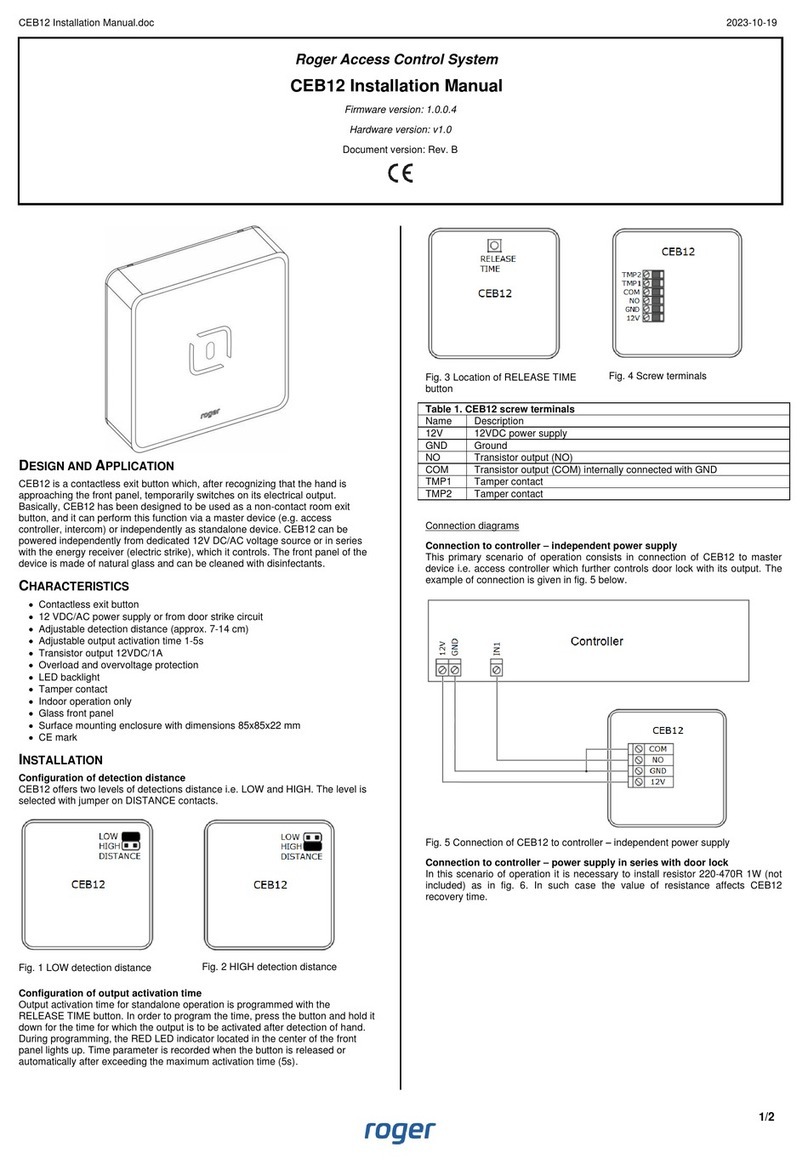
Roger
Roger CEB12 User manual

Roger
Roger MCT68ME-IO-I User manual
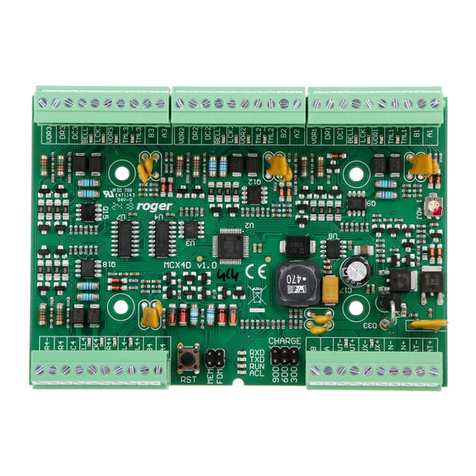
Roger
Roger MCX4D User manual
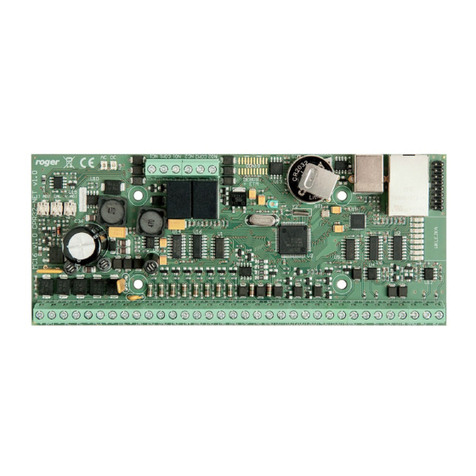
Roger
Roger MC16-PAC-16 User manual
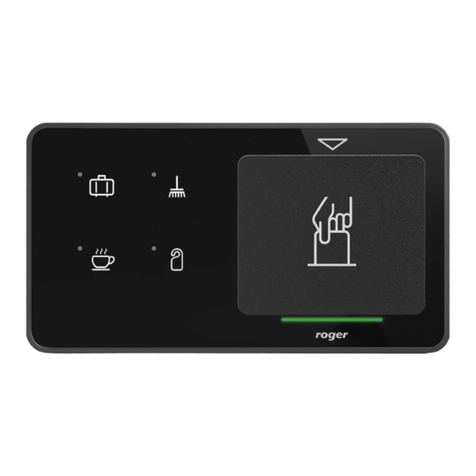
Roger
Roger MCT86M-IO-CH-HR User manual
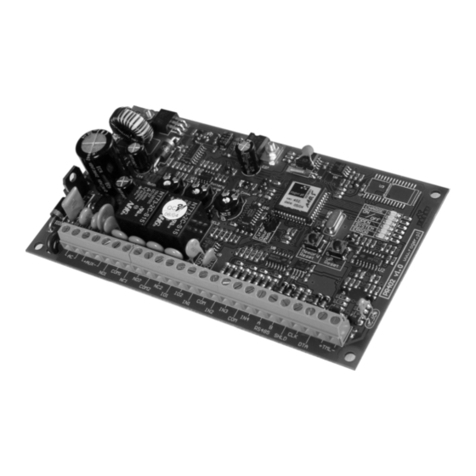
Roger
Roger PR402 User guide
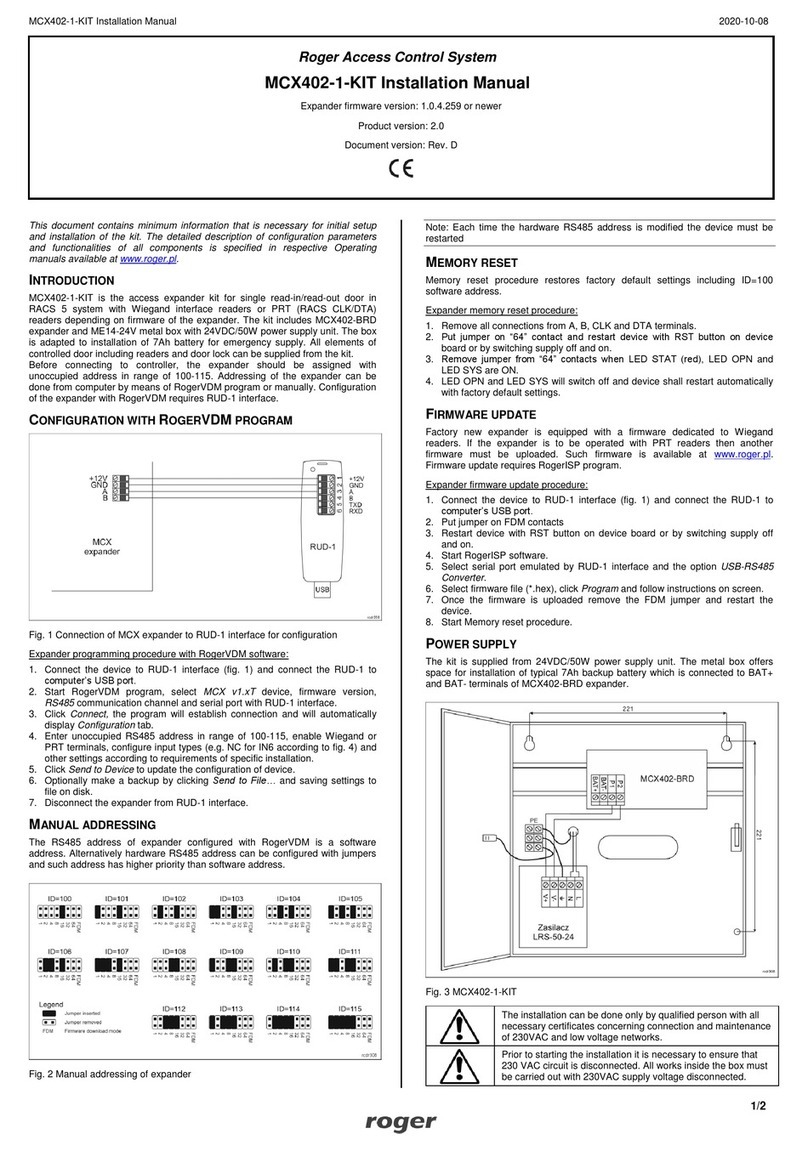
Roger
Roger MCX402-BRD User manual
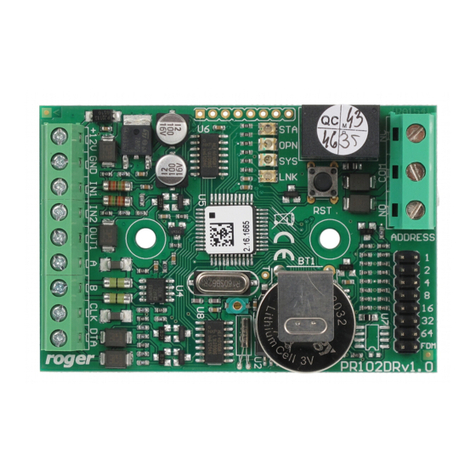
Roger
Roger PR102DR User manual

Roger
Roger MCT82M SERIES User manual
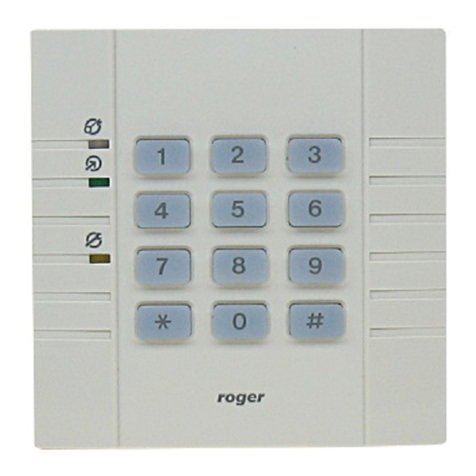
Roger
Roger PR302 User guide

Roger
Roger PR411DR User manual
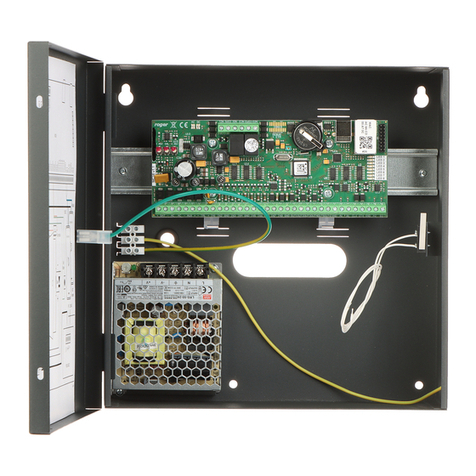
Roger
Roger MC16-PAC-1-KIT User manual

Roger
Roger MC16-PAC-1-KIT User manual
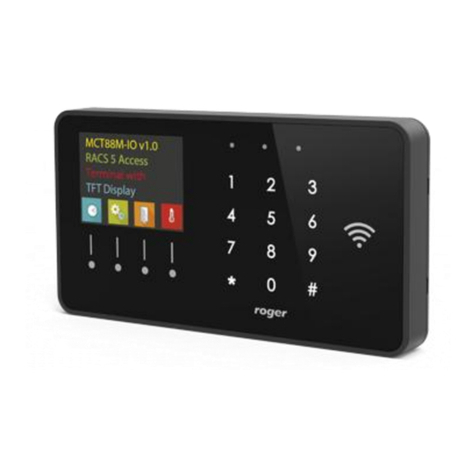
Roger
Roger MCT88M-IO User manual

Roger
Roger PR302 User manual
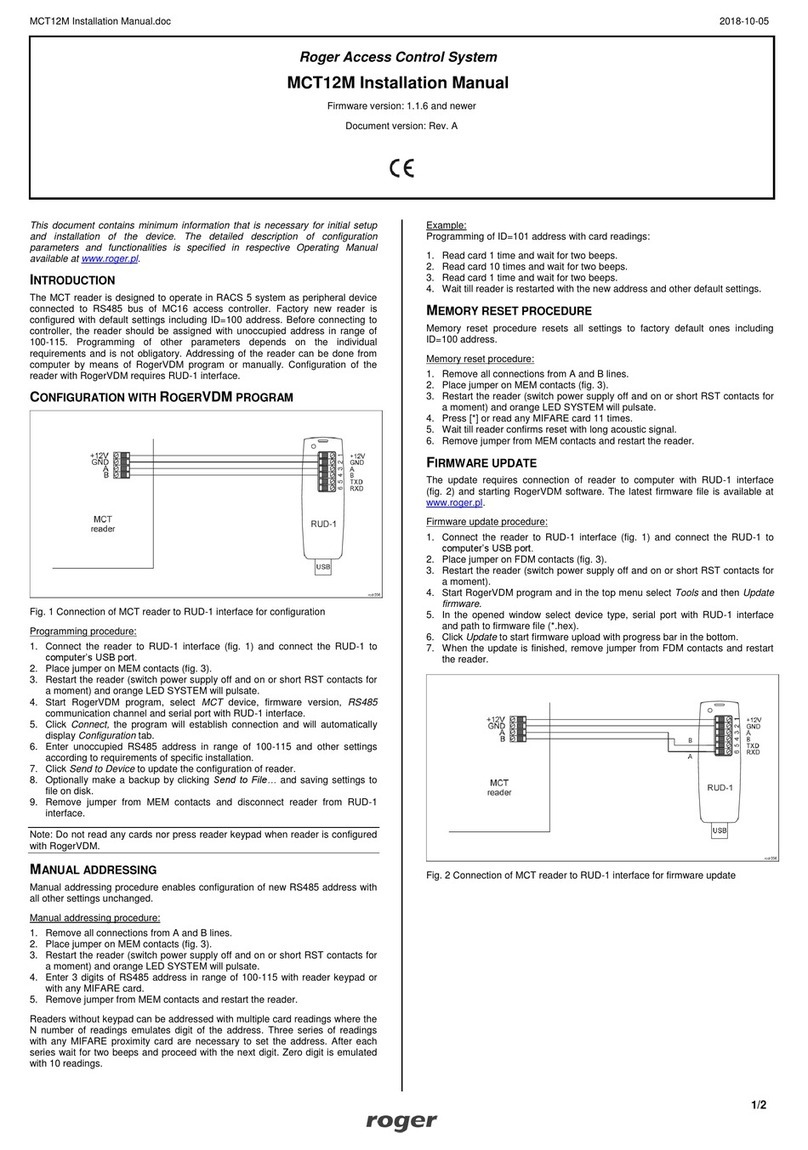
Roger
Roger MCT12M User manual

Roger
Roger MCT88M-IO User manual
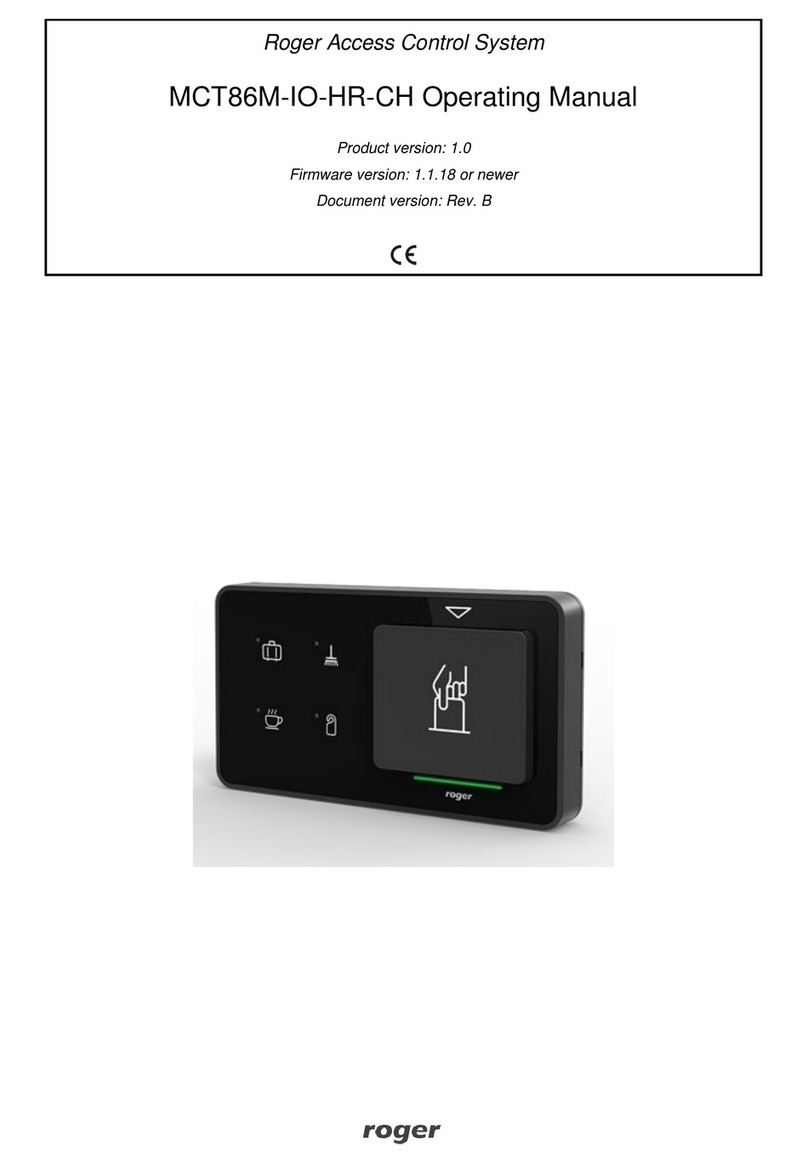
Roger
Roger MCT86M-IO-HR-CH User manual
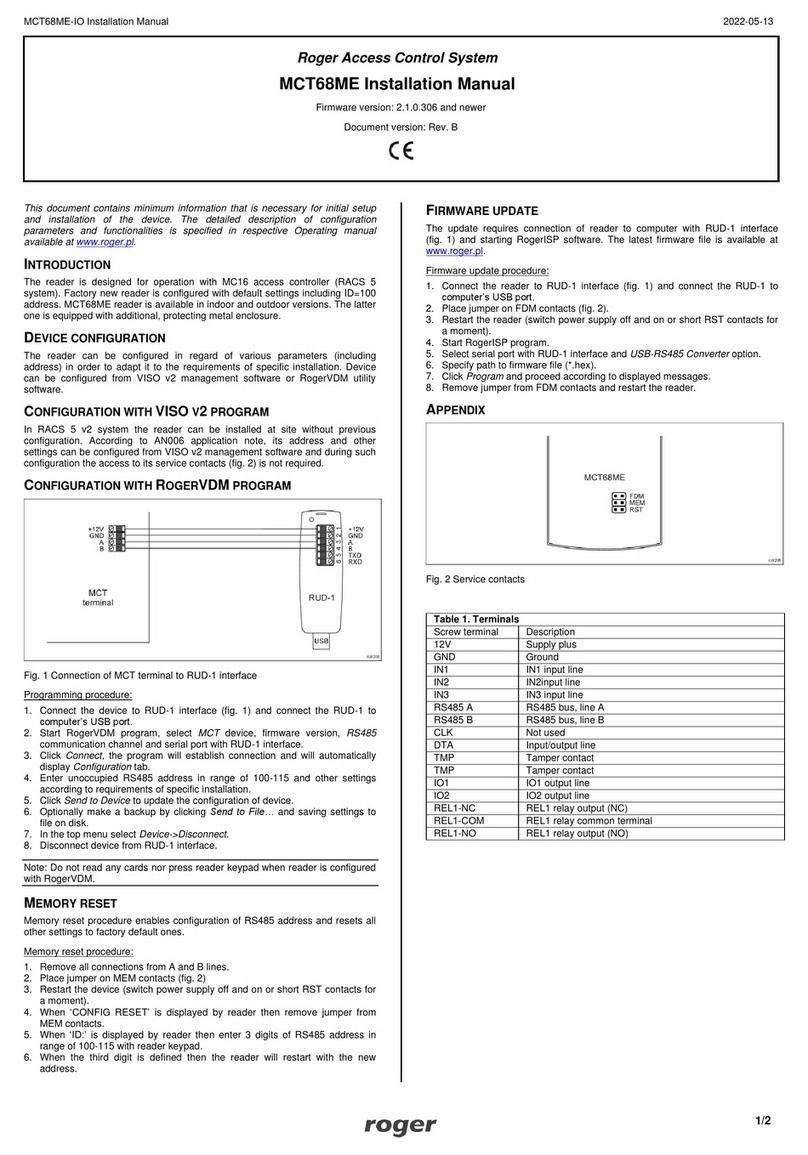
Roger
Roger MCT68ME-IO User manual

Roger
Roger MCT12M User manual
